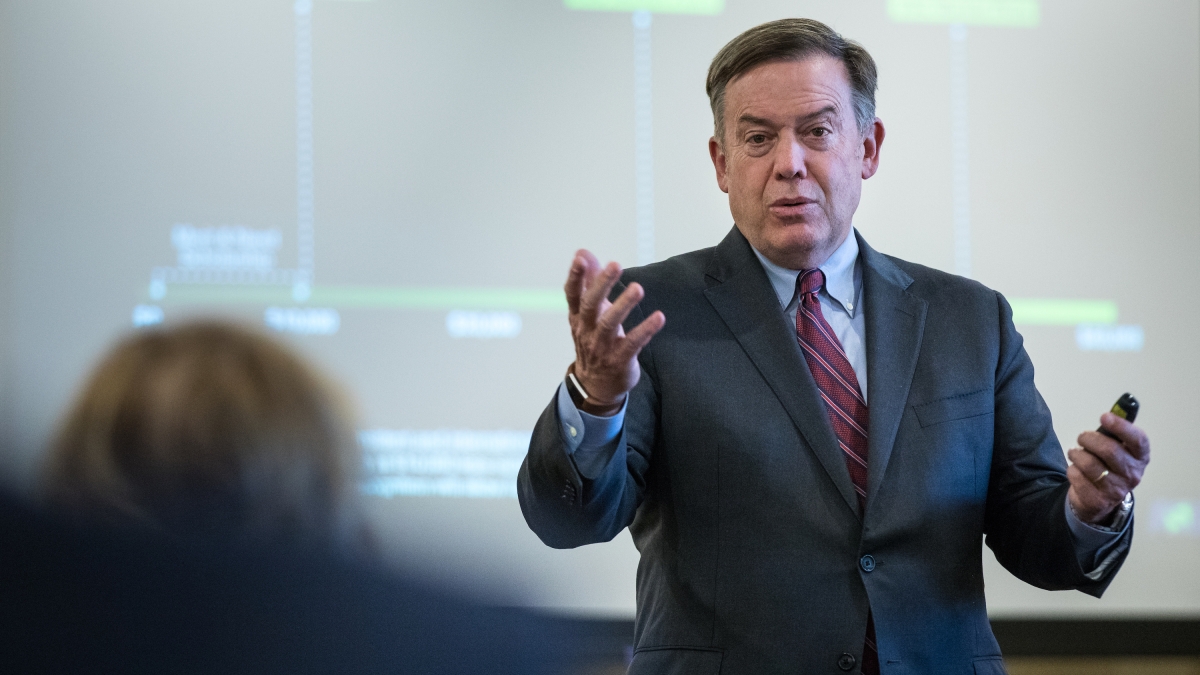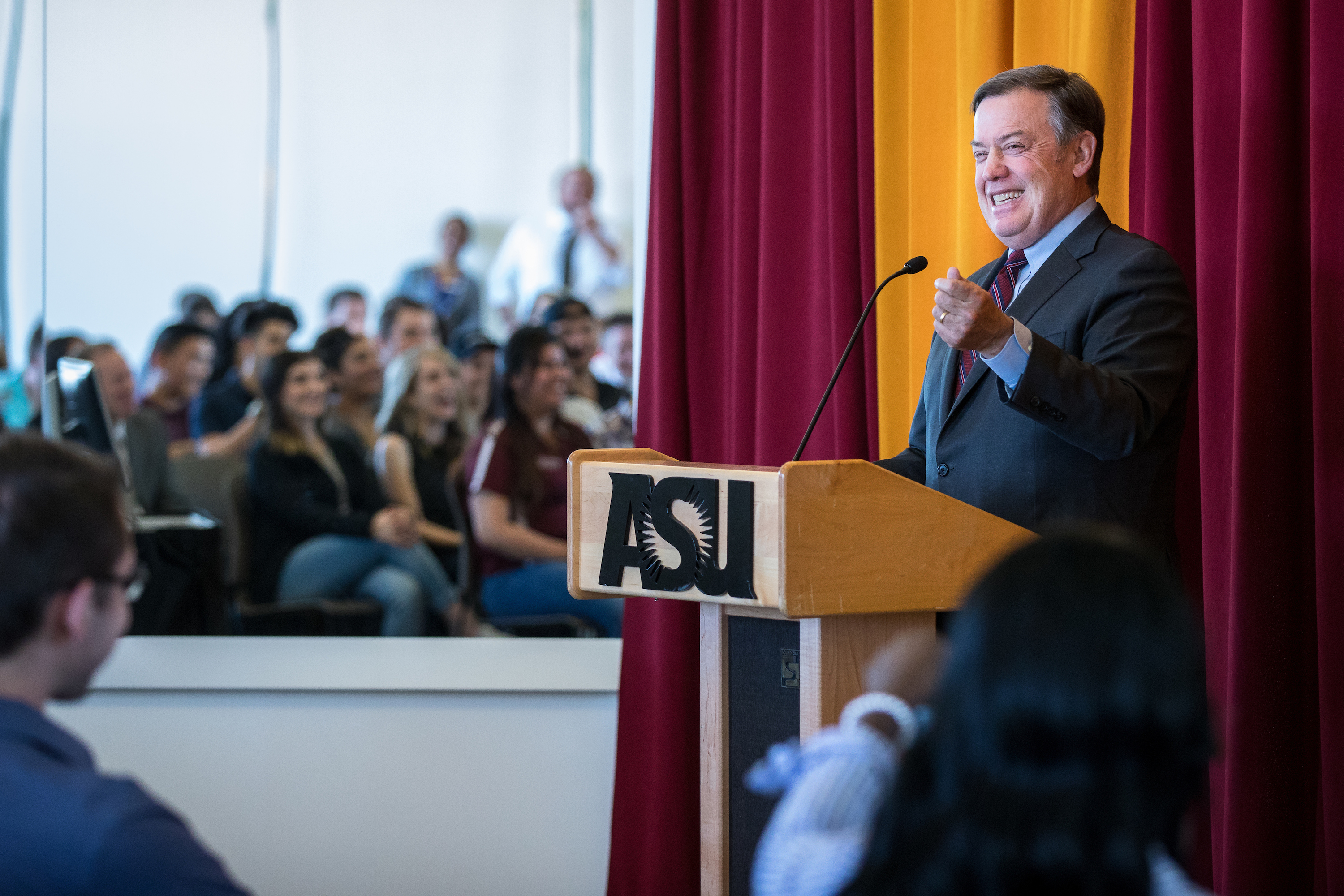ASU President Crow speaks to community leaders at West campus

Arizona State University President Michael M. Crow met with Valley community leaders Thursday afternoon at the West campus to discuss what he called the “public enterprise” university’s progress, current state and future trajectory.
Executive Director of Government and Community Engagement for ASU West campus’ Office of Public Affairs Roberta Magdaleno introduced Crow, stating that “under his leadership, ASU has risen to the top of numerous rankings,” including U.S. News and World Report’s ranking of the “most innovative schools” in the country, which put ASU at number one for the third year in a row.
A number of factors contributed to that, Crow explained Thursday in a presentation titled “A New Era Public Enterprise Model.” A group of about 30 local school officials, business executives and political leaders listened as he outlined ASU’s meteoric rise from an underperforming public agency in 1985 to the model of A New American University today.
Just over three decades ago, ASU was almost wholly reliant on the government for funding, a model which doesn’t do very well, Crow said, “because it’s overwhelmed with politics.”
The four-year graduation rate was at 13.8 percent, with less than 2 percent of students who were Pell Grant-eligible and almost no investment in research.
“If I meet somebody who graduated from ASU in 1985, I shake their hand,” Crow said. “I say, ‘You’re a survivor. You made it through that highly bureaucratized system.’”
When Lattie Coor took over as president of the university in 1990, he made changes that took the institution from underperforming to performing, raising the four-year graduation rate to 28.4 percent, the number of students receiving Pell Grants to 22 percent and research expenditure to $123 million.
Then, in 2002, Crow made the move from Columbia University to the Valley of the Sun and put some radical ideas on the table: inclusivity instead of exclusion, and no more running the university like a government institution.
With this new public enterprise model in place, four-year graduation rates have increased to 51.6 percent. Crow pointed out that ASU actually graduates about 70 percent of “A” students in four years, and about 46 percent of “B” students in four years, the latter being a four-fold increase since 2002 and triple the national average.
Earlier on Thursday, President Crow held a forum at the West campus in which he took questions from students. Photo by Charlie Leight/ASU Now
Of universities that admit both “A” and “B” high school students, ASU has the highest four-year graduation rate in the country, ahead of Purdue and Michigan State. And nearly ninety percent of ASU graduates are in graduate school or employed full-time in 90 days of graduation.
Today, the university’s student body is made up of 35 percent underrepresented minorities, with roughly 34 percent receiving Pell Grants, and research expenditure is at an all-time high of $545 million — more than Stanford, Cambridge or Oxford.
ASU has forged a new path in online education as well, with 30,000 students currently pursuing degrees online.
“This public enterprise model has altered our performance, our outcomes, our achievements, everything,” Crow said.
But there are still obstacles to overcome.
ASU is number 15 in the country out of universities whose graduates go on to work in Silicon Valley. But that means that talent isn’t staying here in Arizona.
Going forward, ASU aims to increase its total enrollment to 125,000 students, 15,000 total degrees offered and $815 million in research expenditures. By 2025, the goal is to be producing four times as many college graduates as it does now.
Crow has proposed a new funding model to the state of Arizona, one that asks it to fund only half the cost of the education of Arizona students.
“For the last 35 years, the state has been paying between $40 and $50 thousand per degree,” Crow said. “Now it’s just $13,000 per degree. That’s a tremendous improvement. All we need [the state] to do is to invest in the students.”
Another issue of concern to Crow and those in attendance on Thursday included the relocation of the Thunderbird School of Global Management from its current location at 59th Avenue and Greenway Road in Glendale to a new building on ASU’s Downtown Phoenix campus.
Crow told Valley leaders that ASU is currently working with the city of Glendale on a new master plan for the 140-acre site that aims to catalyze economic development in the West Valley and accelerate the pace of growth and diversification of economic opportunity.
ASU’s West campus is and will remain home to Thunderbird’s undergraduate program. Crow expressed hopes to grow the campus’ general student enrollment to 10,000 to 15,000 students in the coming years, with expanded degree programs and new learning pathways like the one offered by the Gary K. Herberger Young Scholars Academy.
“We’re continuing to expand our activities everywhere,” Crow said.
